A Straightforward Framework for Road Network Screening to Lombardy Region (Italy)
Abstract
1. Introduction
2. State of the Art on Road Network Screening Methods
- Crash-related segmentation, where the process splits the entire road network based on road crash attributes to identify the endpoints of the road unit (e.g., High Crash Risk Profile), which usually requires sophisticated models [35].
3. Methodology
3.1. Data Sources
- basemap data, i.e., the main map and GIS-based data, which refer to the administrative partition of the selected territory. Specifically, the data about the territorial units for statistics (i.e., NUTS) and related boundaries elements are required. Such data are generally provided as a GIS-based file but also the related spreadsheets are available.
- traffic data, i.e., road identification and traffic volumes data, which refer to mobility patterns. They are considered in terms of link-node basis, where the node represents either an intersection or a change in the cross-section design and the link in the segment of path. More precisely, road name or code are necessary to identify the route. As for traffic volumes, data can be collected by the mean of site measurements or traffic modelling. Such data are generally provided as a GIS-based file, but also the related spreadsheets are available. Additionally, the road class should be gathered, as it would be required to differentiate the screening for different road classes.
- crash data, i.e., road crashes occurred within the study area, the number of road deaths and injuries (i.e., severity attributes). In addition, crash location is required to match crashes to road paths (e.g., jurisdiction, road name or code). Other data (e.g., road site type, environmental conditions) may be useful for specific insights. Such data are generally provided as a spreadsheets file and are retrieved from national statistics template or police crash records.
3.2. Procedure Steps
- be the set of the territorial jurisdiction within the study area, and be a generic jurisdiction;
- be the set of routes traversing jurisdiction , and be a generic road;
- be the set of road segments of route r , , and s be a generic segment;
- r,j be the set of all segments s of route r , , and r,j be a generic path.
- be the length of a generic segment s ;
- be the AADT of a generic segment s .
- be the set of road crashes occurred on the route r , , and be a generic crash;
- be the set of road deaths occurred on the route r , , and be a generic road death;
- be the set of road injuries occurred on the route r , , and be a generic injury.
4. Real-World Application
4.1. Case Study
4.2. Applicative Setup
4.3. Framework Development
4.4. A Numerical Example
- the is the sum of all the values computed for each row. Results are shown in Table 6.
5. Results and Discussion
6. Conclusions and Research Perspectives
- Handling crash location data without using plane and/or geographical coordinates, because crash-coordinate data are still missing or poorly recorded in many countries.
- Adopting other location attributes to associate the crash and related traffic data and base map attributes to a road segment. Although this new way to ‘localise’ crash data needs for a new segmentation type named ‘path’ (i.e., the portion of a generic road within the boundaries of the lowest territorial jurisdiction at hand), it aims to provide a more accurate screening of the network, because all crashes data are considered.
- Proposing a simple, but complete Adjusted Accident Cost Rate Index. Besides representing a novel safety metric and including cost criteria in the evaluation of crashes, this index aggregates in one measure the main components of risk, i.e., the frequency of accidents, the exposure measure, and the severity. Although this index is not being able to account for the regression-to-the-mean bias, it was introduced because it is easy to understand, simple to interpret, and straightforward to assess using basic statistics.
- Enabling a general and multiple-level network screening, since the computational process can adapt itself, depending on the territorial jurisdiction considered (e.g., regional, provincial, and local scale): the crash rate values are shown by GIS variable maps at different administrative levels.
- The framework is based on an easy-to-implement five-steps procedure for the RNS, when poor data quality occurs. This enables a high degree of replicability and adaptability above all practitioners that often presents uncertainties and inaccuracies on plane and/or geographical coordinates for crashes.
- The 5-level ranking scale built according to the novel safety metric enables a clear identification of the most critical paths, and this is essential to direct strategies and allocate funds more efficiently.
- The road network screening at different administrative levels enables road authorities and administrations to approach the network they manage differently. Thus, the path is referred to the regional, provincial, or local level. In addition, given the rationale of the entire process, it can be intended as a “black spot” identification procedure, in that it enables us to quantitatively highlight the paths with the highest social-cost burden (thus it also returns an economic appraisal) that the number of road crashes that have occurred have produced. Indeed, the proposed screening is like a typical “black spot” identification, which is conducted by a jurisdiction to identify the “high crash locations.”
- The procedure, coherently to each screening process, enables us to allocate resources more efficiently as in-depth analysis about the causes of such low safety performance can be focused on those most critical paths. Then, e.g., infrastructural layout, environmental factors, or traffic components can be further investigated to identify issues (e.g., presence of several intersections and quite heavy freight vehicles) and define how to intervene, e.g. [44,45].
Author Contributions
Funding
Institutional Review Board Statement
Informed Consent Statement
Data Availability Statement
Conflicts of Interest
References
- European Commission. EU Road Safety Policy Framework 2021–2030-Next Steps towards “Vision Zero”; Publications Office of the European Union: Luxembourg, 2019. [Google Scholar]
- World Health Organization–WHO. Global Status Report on Road Safety 2018. 2018. Available online: https://www.who.int/publications/i/item/9789241565684 (accessed on 1 December 2021).
- Wijnen, W.; Weijermars, W.; Schoeters, A.; van den Berghe, W.; Bauer, R.; Carnis, L.; Elvik, R.; Martensen, H. An analysis of official road crash cost estimates in European countries. Saf. Sci. 2019, 113, 318–327. [Google Scholar] [CrossRef]
- European Union. Directive 2008/96/EC of the European Parliament and of the Council on Road Infrastructure Safety Management; Publications Office of the European Union: Luxembourg, 2008. [Google Scholar]
- Persia, L.; Usami, D.S.; De Simone, F.; Beaumelle, V.F.D.; La Yannis, G.; Laiou, A.; Han, S.; Machata, K.; Pennisi, L.; Marchesini, P.; et al. Management of Road Infrastructure Safety. Transp. Res. Procedia 2016, 14, 3436–3445. [Google Scholar] [CrossRef]
- European Union. Directive 2019/1936 of the European Parliament and of the Council Amending Directive 2008/96/EC on Road Infrastructure Safety Management; Publications Office of the European Union: Luxembourg, 2019; Volume 2019. [Google Scholar]
- Elvik, R.; Vaa, T.; Hoye, A.; Sorensen, M. The handbook of Road Safety Measures. In Elsevier Science; Emerald Group Publishing: Bingley, UK, 2009. [Google Scholar]
- Elvik, R. Assessment and Applicability of Road Safety Management Evaluation Tools: Current Practice and State-of-the-Art in Europe; Norwegian Institute of Transport Economics: Oslo, Norway, 2010. [Google Scholar]
- Park, P.Y.; Sahaji, R. Safety network screening for municipalities with incomplete traffic volume data. Accid. Anal. Prev. 2013, 50, 1062–1072. [Google Scholar] [CrossRef]
- Stipancic, J.; Miranda-Moreno, L.; Saunier, N.; Labbe, A. Network screening for large urban road networks: Using GPS data and surrogate measures to model crash frequency and severity. Accid. Anal. Prev. 2019, 125, 290–301. [Google Scholar] [CrossRef] [PubMed]
- Ghadi, M.; Török, Á. A comparative analysis of black spot identification methods and road accident segmentation methods. Accid. Anal. Prev. 2019, 128, 1–7. [Google Scholar] [CrossRef]
- FHA. Highway Safety Manual, 1st ed.; American Association of State Highway and Transportation Officials: Washington, DC, USA, 2010. [Google Scholar]
- Lord, D.; Mannering, F. The statistical analysis of crash-frequency data: A review and assessment of methodological alternatives. Transp. Res. Part A Policy Pract. 2010, 44, 291–305. [Google Scholar] [CrossRef]
- Mannering, F.L.; Bhat, C.R. Analytic methods in accident research: Methodological frontier and future directions. Anal. Methods Accid. Res. 2014, 1, 1–22. [Google Scholar] [CrossRef]
- Jiang, X.; Abdel-Aty, M.; Alamili, S. Application of Poisson random effect models for highway network screening. Accid. Anal. Prev. 2014, 63, 74–82. [Google Scholar] [CrossRef]
- Montella, A. A comparative analysis of hotspot identification methods. Accid. Anal. Prev. 2010, 42, 571–581. [Google Scholar] [CrossRef]
- Thakali, L.; Kwon, T.J.; Fu, L. Identification of crash hotspots using kernel density estimation and kriging methods: A comparison. J. Mod. Transp. 2015, 23, 93–106. [Google Scholar] [CrossRef]
- Ambros, J.; Jurewicz, C.; Turner, S.; Kieć, M. An international review of challenges and opportunities in development and use of crash prediction models. Eur. Transp. Res. Rev. 2018, 10, 35. [Google Scholar] [CrossRef]
- Kuo, P.F.; Lord, D.; Walden, T.D. Using geographical information systems to organize police patrol routes effectively by grouping hotspots of crash and crime data. J. Transp. Geogr. 2013, 30, 138–148. [Google Scholar] [CrossRef]
- SETRA. Démarche SURE-Étude D’Enjeux de Sécurité Routière pour la Hiérarchisation des Itinéraires; Bagneux Cedex: Setrà, France, 2006. [Google Scholar]
- Elvik, R. State-of-the-Art Approaches to Road Accident Black Spot Management and Safety Analysis of Road Networks (TØI Report); Norwegian Institute of Transport Economics: Oslo, Norway, 2007. [Google Scholar]
- EuroRAP. RAP Crash Risk Mapping: Technical Specification; EuroRAP: Brussels, Belgium, 2020. [Google Scholar]
- MIT. Linee Guida per la Gestione Della Sicurezza delle Infrastrutture Stradali ai Sensi dell’Articolo 8 del Decreto Legislativo 15 Marzo 2011, n. 35; Ministero delle infrastrutture e dei trasporti: Roma, Italy, 2012. [Google Scholar]
- Borghetti, F.; Marchionni, G.; De Bianchi, M.; Barabino, B.; Bonera, M.; Caballini, C. A new methodology for accidents analysis: The case of the State Road 36 in Italy. Int. J. Transp. Dev. Integr. 2021, 5, 278–290. [Google Scholar] [CrossRef]
- Schlögl, M.; Stütz, R. Methodological considerations with data uncertainty in road safety analysis. Accid. Anal. Prev. 2019, 130, 136–150. [Google Scholar] [CrossRef] [PubMed]
- European Commission. Road Safety Press Release. European Commission Website. 2021. Available online: https://ec.europa.eu/info/index_en (accessed on 20 April 2021).
- Forschungsgesellschaft Straße - Schiene – Verkehr – FSV. Austrian Guideline Code for Planning, Construction and Maintenance of Roads; FSV: Wien, Austria, 2002. [Google Scholar]
- Vistisen, D. Models and Methods for Hot Spot Safety Work. Ph.D. Thesis, Department for Informatics and Mathematical Models, Technical University of Denmark, Kongens Lyngby, Copenhagen, Denmark, 2002. [Google Scholar]
- German Road and Transportation Research Association - FGSV. Recommendation on Accident Type Maps including Detailed Definitions Regarding Black Spot Detection and Analysis; FGSV: Cologne, Germany, 2006. [Google Scholar]
- Mamčic, S.; Sivilevičius, H. The analysis of traffic accidents on Lithuanian regional gravel roads. Transport 2013, 28, 108–115. [Google Scholar] [CrossRef]
- FHA. Officials Highway Safety Manual, Part B; American Association of State Highway and Transportation: Washington, DC, USA, 2010; p. 19192. [Google Scholar]
- Montella, A.; Chiaradonna, S.; Criscuolo, G.; De Martino, S. Development and evaluation of a web-based software for crash data collection, processing and analysis. Accid. Anal. Prev. 2019, 130, 108–116. [Google Scholar] [CrossRef]
- Elyasi, M.R.; Saffarzade, M.; Boroujerdian, A.M. A novel dynamic segmentation model for identification and prioritization of black spots based on the pattern of potential for safety improvement. Transp. Res. Part A Policy Pract. 2016, 91, 346–357. [Google Scholar] [CrossRef]
- Kwon, O.H.; Park, M.J.; Yeo, H.; Chung, K. Evaluating the performance of network screening methods for detecting high collision concentration locations on highways. Accid. Anal. Prev. 2013, 51, 141–149. [Google Scholar] [CrossRef]
- Boroujerdian, A.M.; Saffarzadeh, M.; Yousefi, H.; Ghassemian, H. A model to identify high crash road segments with the dynamic segmentation method. Accid. Anal. Prev. 2014, 73, 274–287. [Google Scholar] [CrossRef]
- Imprialou, M.; Quddus, M. Crash data quality for road safety research: Current state and future directions. Accid. Anal. Prev. 2019, 130, 84–90. [Google Scholar] [CrossRef]
- Gupta, A.; Bansal, A. Integrating Traffic Datasets for Evaluating Road Networks. In Proceedings of the 12th IEEE International Conference on Semantic Computing, ICSC 2018, Laguna Hills, CA, USA, 31 January–2 February 2018; pp. 411–416. [Google Scholar]
- Fine, W.T. Mathematical Evaluations for Controlling Hazards. J. Saf. Res. 1971, 3, 157–166. [Google Scholar]
- Viera Gomes, S.; Cardoso, J.L.; Azevedo, C.L. Portuguese mainland road network safety performance indicator. Case Stud. Transp. Policy 2018, 6, 416–422. [Google Scholar] [CrossRef]
- Yannis, G.; Weijermars, W.; Gitelman, V.; Vis, M.; Chaziris, A.; Papadimitriou, E.; Azevedo, C.L. Road safety performance indicators for the interurban road network. Accid. Anal. Prev. 2013, 60, 384–395. [Google Scholar] [CrossRef] [PubMed]
- Bonera, M.; Barabino, B.; Maternini, G. Road Network Safety Screening of County Wide Road Network. The Case of the Province of Brescia (Northern Italy). In International Road Federation World Meeting & Exhibition; Springer: Cham, Switzerland, 2022; pp. 525–541. [Google Scholar]
- Hosseinpour, M.; Yahaya, A.S.; Sadullah, A.F. Exploring the effects of roadway characteristics on the frequency and severity of head-on crashes: Case studies from Malaysian Federal Roads. Accid. Anal. Prev. 2014, 62, 209–222. [Google Scholar] [CrossRef]
- MIT. Ministero delle Infrastrutture e dei Trasporti Costi Sociali dell’Incidentalità Stradale; MIT: Rome, Italy, 2017. [Google Scholar]
- Russo, F.; Comi, A. From the analysis of European accident data to safety assessment for planning: The role of good vehicles in urban area. Eur. Transp. Res. Rev. 2017, 9, 9. [Google Scholar] [CrossRef]
- Russo, F.; Comi, A. Urban freight transport and weak road user: Goods vehicles and pedestrians. In L’utente debole nelle intersezioni stradali: Studi e ricerche per la sicurezza stradale del pedone, del ciclista e delle persone con disabilità/a cura di Felice Giuliani; Egaf: Forlì, Italy, 2014; pp. 285–298. [Google Scholar]
- Porcu, F.; Olivo, A.; Maternini, G.; Barabino, B. Evaluating bus accident risks in public transport. Transp. Res. Procedia 2020, 45, 443–450. [Google Scholar] [CrossRef]
- Porcu, F.; Olivo, A.; Maternini, G.; Coni, M.; Bonera, M.; Barabino, B. Assessing the risk of bus crashes in transit systems. Eur. Transp.-Trasp. Eur. 2021, 81. [Google Scholar] [CrossRef]
- Barabino, B.; Bonera, M.; Maternini, G.; Olivo, A.; Porcu, F. Bus crash risk evaluation: An adjusted framework and its application in a real network. Accid. Anal. Prev. 2021, 159, 106258. [Google Scholar] [CrossRef]
- Martinelli, V.; Ventura, R.; Bonera, M.; Barabino, B.; Maternini, G. Estimating Operating Speed for County Roads’ Segments-Evidence from Italy. Int. J. Transp. Sci. Technol. 2022, in press. [Google Scholar] [CrossRef]
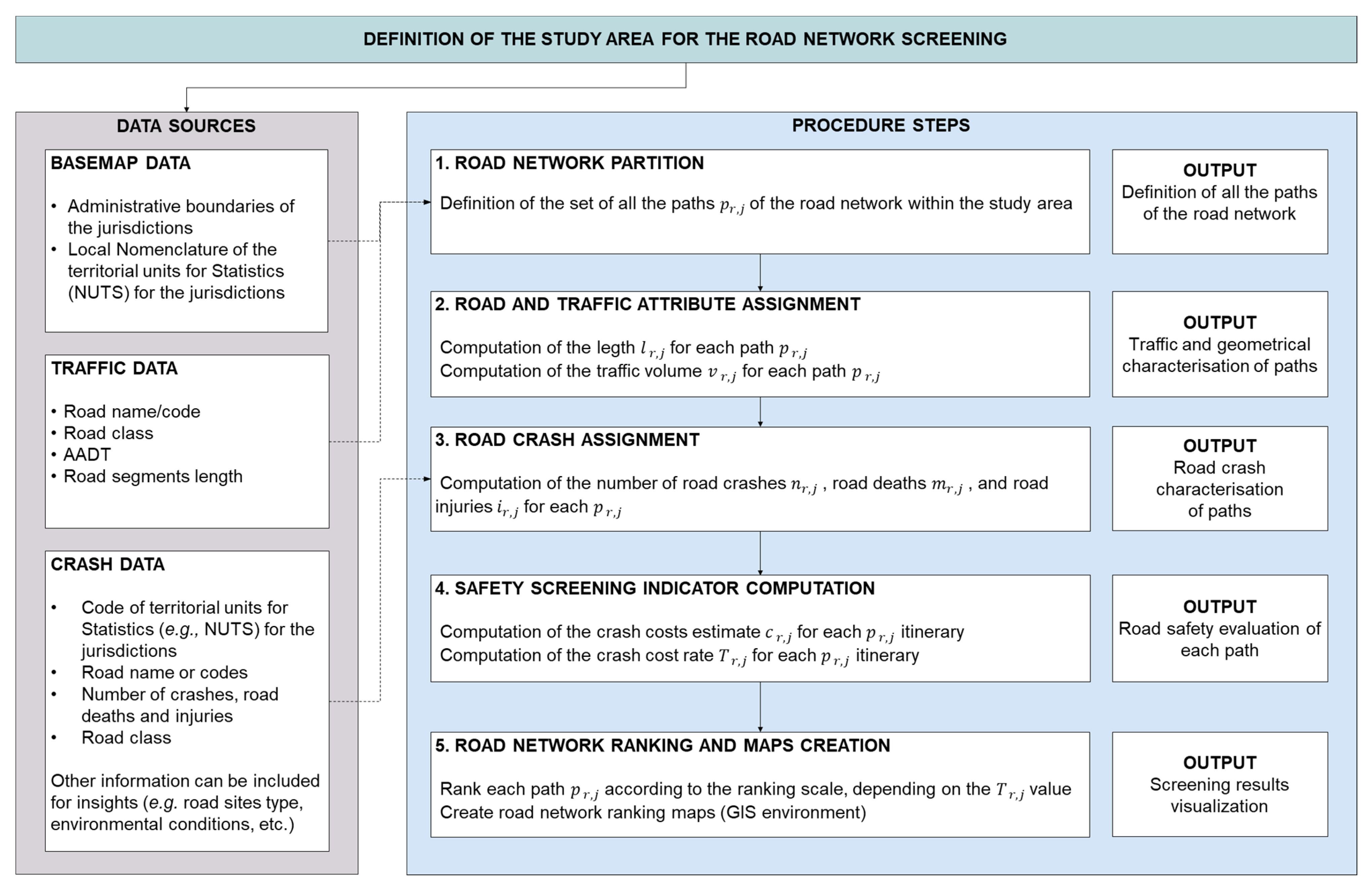
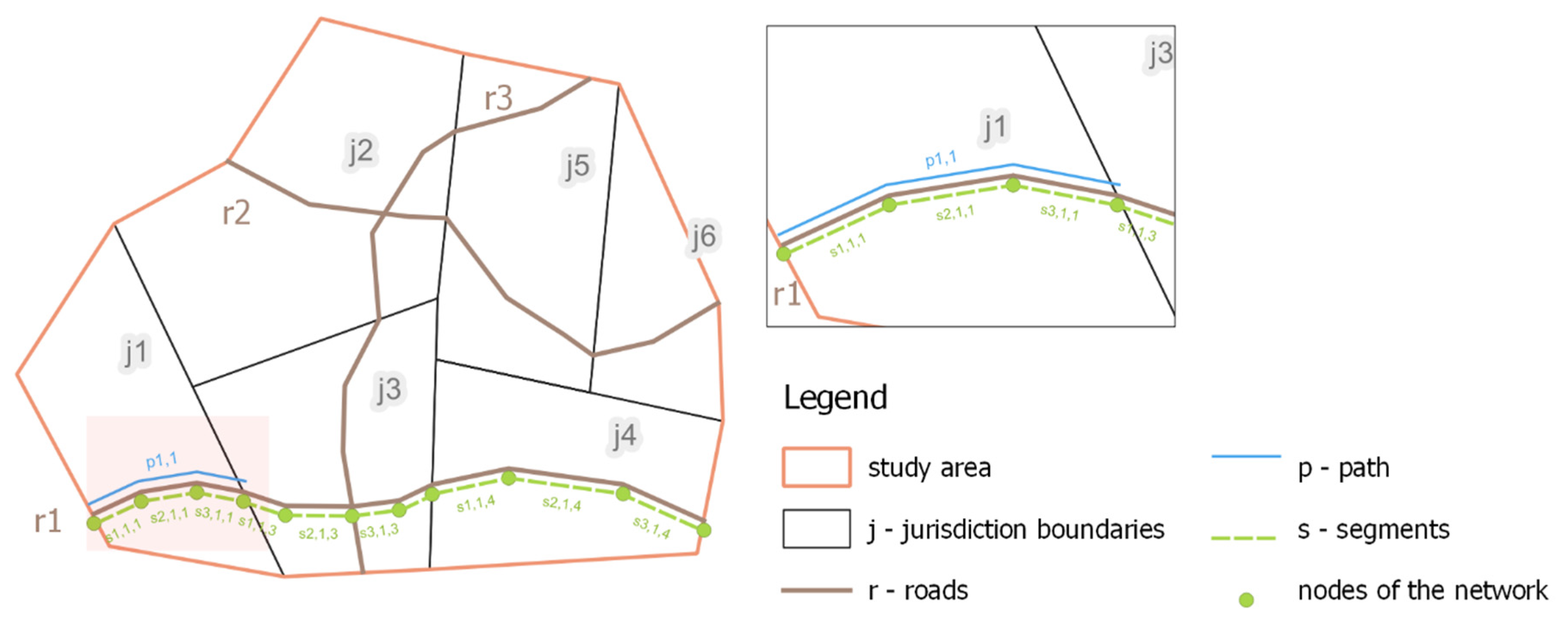
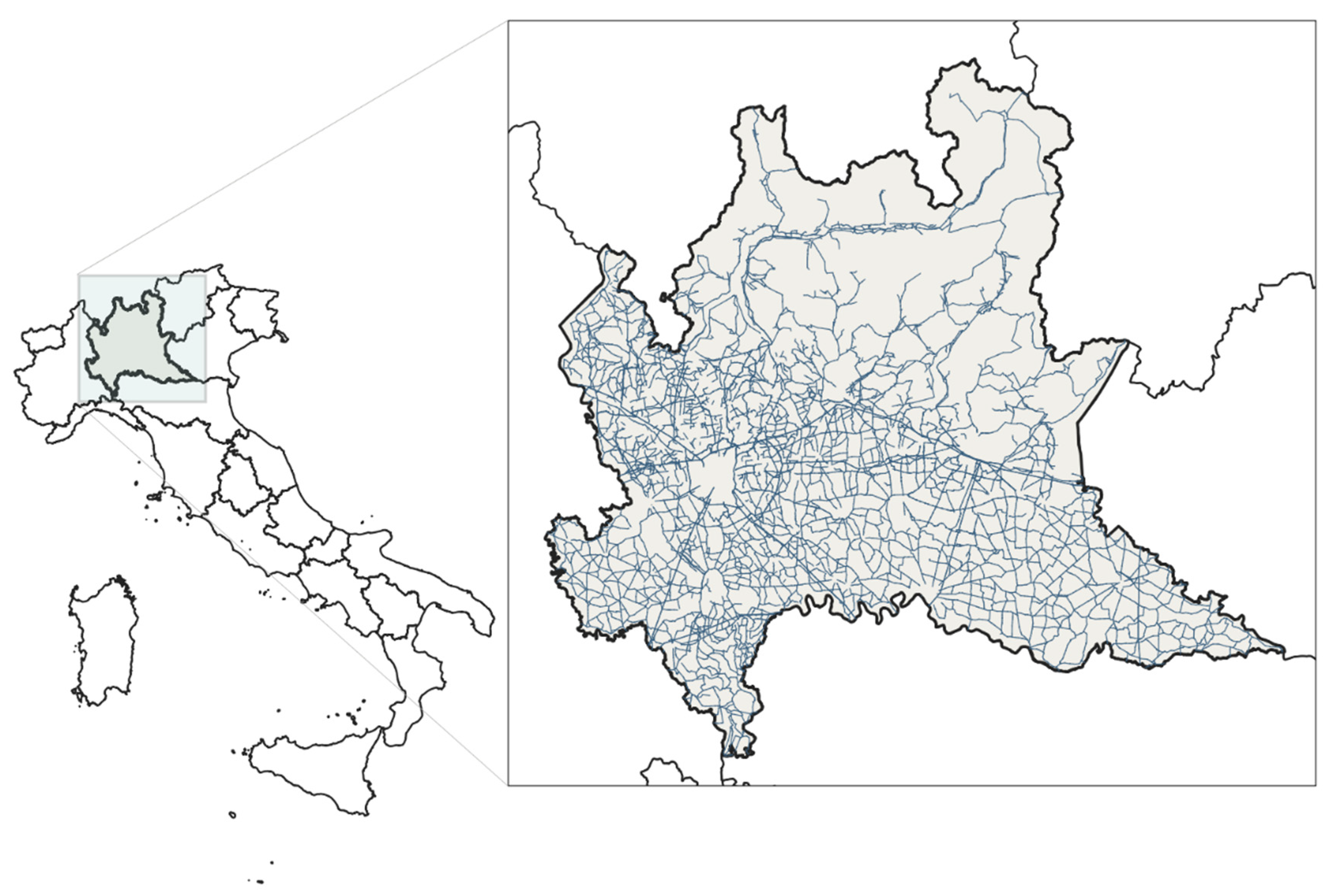

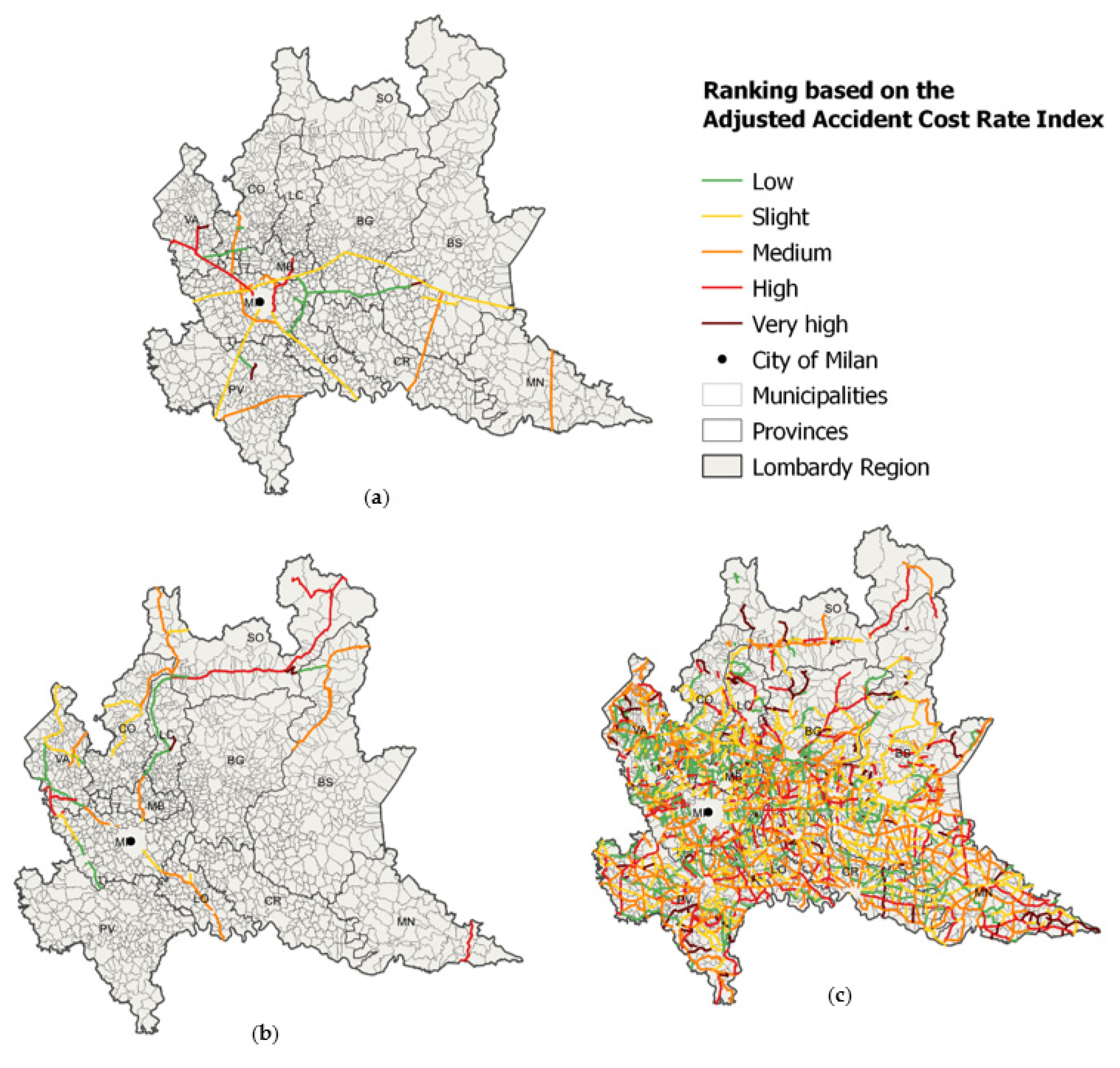
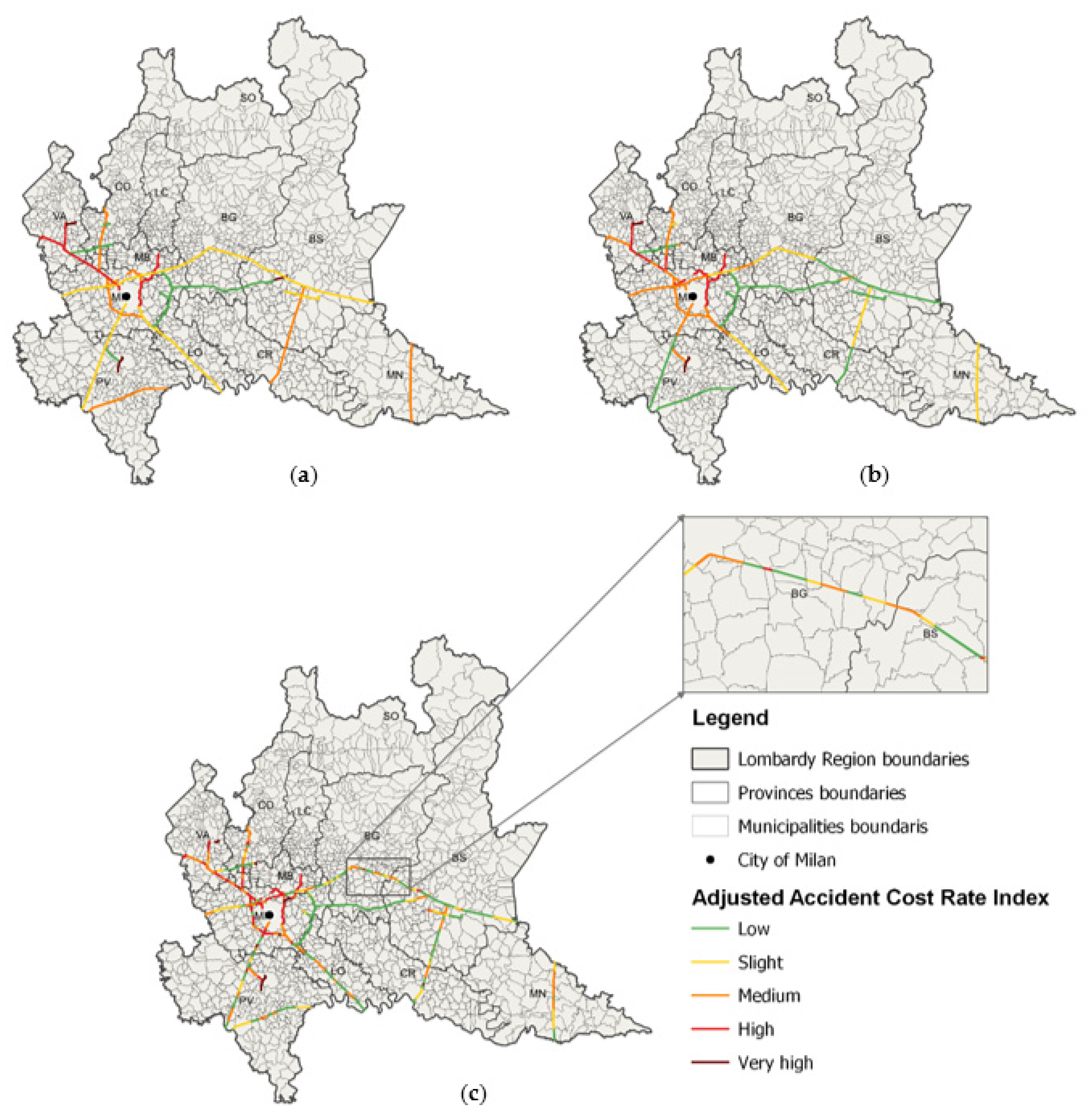
| Authors | Country | I - Road Segmentation | II - Black Spot Identification | III Black Spot Visualisation | Pros | Cons |
|---|---|---|---|---|---|---|
| Austrian Guideline Code, [27] | Austria | Fixed length Sliding windows | Accident rate | Tables, fixed maps | • Exposure measurement considered | • Necessary accurate accident locations (plane or geographic coordinates) • Necessary traffic data • Severity is considered a part |
| Vistisen, [28] | Denmark | Sliding windows for road section, variable length | Test on the Poisson distribution model | Tables, fixed maps | • Necessary only data accidents | • Necessary accurate accident locations (plane or geographic coordinates) • Severity and exposure measurement are neglected |
| SETRA, [20] 1 | France | Road, Road portion, road section, sliding windows, fixed | Safety Potential | Tables, fixed maps | • Economic impact of missed accidents • Measurement combined for the segment and the sliding windows | • Necessary accurate accident locations (plane or geographic coordinates) • Frequency, severity and exposure information clustered in two indexes • Necessary several source of data • Proprietary software |
| German Road and Transportation Research Association, [29] | Germany | Accident maps inspected | Accident frequency | Maps | • Straightforward index • Necessary only data accidents | • Only graphical representation • Necessary accurate accident locations (plane or geographic coordinates) • Severity is included by mean of critical values • Exposure is neglected |
| Elvik, [21] 2 | Belgium (Flanders), Hungary, Norway | Fixed length Sliding windows | Accident frequency | Tables, fixed maps | • Straightforward index • Necessary only data accidents | • Necessary accurate accident locations (plane or geographic coordinates) • Severity and exposure measurement are almost neglected (e.g., severity by mean of weights) |
| Elvik, [21] 2 | Switzerland | Fixed sections of variable length | Accident frequency | Tables, fixed maps | • Straightforward index • Necessary only data accidents | • Necessary accurate accident locations (plane or geographic coordinates) • Severity is included by mean of critical values • Exposure is neglected |
| Elvik, [21] 2 | Portugal | Fixed length Sliding windows | Accident rate | Tables, fixed maps | • Exposure measurement considered | • Necessary accurate accident locations (plane or geographic coordinates) • Necessary traffic data • Severity is considered a part, depending on the definition of black spot considered |
| Euro RAP, [22] | Europe | Roads | Accident rate | Tables, fixed maps | • Exposure measurement considered | • Necessary traffic data • Aggregate index for the overall road • Severity is considered a part • Gradual Fixed value ranking scale • Proprietary software |
| MIT, [23] | Italy | Fixed length and cross-section segment | Accident rate, Accident frequency, Number of Accidents | Tables | • Straightforward index • Exposure measurement considered • Index flexibility based on data availability | • Necessary traffic data • Necessary Segment cross-section feature • Severity is considered partially |
| Mamčic and Sivilevičius, [30] | Lithuania | Road portion | Accident rate | Tables, fixed maps | • Exposure measurement considered | • Necessary accurate accident locations (plane or geographic coordinates) • Necessary traffic data • Severity is considered a part |
| FHA, [31] | USA | Fixed length Sliding windows | Set of performance measures | Tables | • Performance measure flexibility based on data availability | • Necessary accurate accident locations (plane or geographic coordinates) • Roadway information for road categorisations always needed • Exposure measurement not always considered |
| This paper | Italy | Road section of variable length also depending on the administrative boundaries | Adjusted accident cost rate index | Tables, variable maps include several administrative boundaries | • Unnecessary accurate accident locations • Frequency, severity, and exposure measurement clustered in one index • Economic impact of occurred accidents | • Necessary several data sources |
| Level of Unsafety | Ranges Values (AACRI) | Expected Action | ||
|---|---|---|---|---|
| Lower Limit | Upper Limit | |||
| 5 | Very high | (Q3 + 1.5 × IQR) | MAX | Urgently proceed with in-depth on-site inspection |
| 4 | High | Q3 | (Q3 + 1.5 × IQR) | Proceed with in-depth analysis (either on-site or off-site) |
| 3 | Medium | Q2 | Q3 | Plan an inspection campaign |
| 2 | Slight | Q1 | Q2 | Just need to monitor the AACRI over time |
| 1 | Low | (Q1 − 1.5 × IQR) | Q1 | No specific need to intervene |
| Path Codes for Each Jurisdictional Level | s-Segment | ||
|---|---|---|---|
| Regional Path | Provincial Path | Municipality Path | |
| A04 | A04_17 | A04_17029 | 41681 |
| A04 | A04_17 | A04_17029 | 43981 |
| A04 | A04_17 | A04_17029 | … |
| A04 | A04_17 | A04_17127 | 40249 |
| A04 | A04_17 | A04_17127 | 41641 |
| A04 | A04_17 | A04_17127 | … |
| A04 | A04_17 | … | … |
| A04 | A04_16 | A04_16051 | 31690 |
| A04 | A04_16 | A04_16051 | 32118 |
| A04 | A04_16 | A04_16051 | … |
| A04 | A04_16 | A04_16037 | 32117 |
| A04 | A04_16 | A04_16037 | 32146 |
| A04 | A04_16 | A04_16037 | … |
| A04 | A04_16 | … | … |
| A04 | … | … | … |
| Cost Unit Estimates Items | Cost Estimate [€] |
|---|---|
| Average road crash cost () | 10,986.00 € |
| Average human road death cost () | 1,503,990.00 € |
| Average human injury cost () | 42,219.00 € |
| Paths | Path Length - [km] (a) | Traffic Volume - [Veh/Day] (b) | No. of Crash (c) - | No. of Deaths (d) - | No. of Injuries (e) - |
|---|---|---|---|---|---|
| A01_15071 | 6.68 | 44,927 | 4 | 1 | 9 |
| A01_15140 | 2.33 | 51,298 | 7 | 1 | 10 |
| A01_15146 | 1.27 | 36,567 | 1 | 0 | 1 |
| A01_15192 | 5.35 | 42,030 | 8 | 1 | 9 |
| A01_15195 | 12.8 | 46,170 | 29 | 1 | 48 |
| A01_15202 | 6.38 | 45,172 | 10 | 0 | 19 |
| Paths | ||||
|---|---|---|---|---|
| A01_15071 | 43,944 | 1,503,990 | 379,971 | 1,927,905 |
| A01_15140 | 76,902 | 1,503,990 | 422,190 | 2,003,082 |
| A01_15146 | 10,986 | 0 | 42,219 | 53,205 |
| A01_15192 | 87,888 | 1,503,990 | 379,971 | 1,971,849 |
| A01_15195 | 318,594 | 1,503,990 | 2,026,512 | 3,849,096 |
| A01_15202 | 109,860 | 0 | 802,161 | 912,021 |
| Paths | Social Costs [€] | Path Length [km] | Traffic Volume [Veh/Day] | [€/Mil-Veh × km] |
|---|---|---|---|---|
| A01_15071 | 1,927,905 | 6.68 | 44,927 | 17,599.85 |
| A01_15140 | 2,003,082 | 2.33 | 51,298 | 45,914.46 |
| A01_15146 | 53,205 | 1.27 | 36,567 | 3138.82 |
| A01_15192 | 1,971,849 | 5.35 | 42,030 | 24,025.23 |
| A01_15195 | 3,849,096 | 12.8 | 46,170 | 17,844.16 |
| A01_15202 | 912,021 | 6.38 | 45,172 | 8670.06 |
Publisher’s Note: MDPI stays neutral with regard to jurisdictional claims in published maps and institutional affiliations. |
© 2022 by the authors. Licensee MDPI, Basel, Switzerland. This article is an open access article distributed under the terms and conditions of the Creative Commons Attribution (CC BY) license (https://creativecommons.org/licenses/by/4.0/).
Share and Cite
Bonera, M.; Barabino, B.; Maternini, G. A Straightforward Framework for Road Network Screening to Lombardy Region (Italy). Sustainability 2022, 14, 12424. https://doi.org/10.3390/su141912424
Bonera M, Barabino B, Maternini G. A Straightforward Framework for Road Network Screening to Lombardy Region (Italy). Sustainability. 2022; 14(19):12424. https://doi.org/10.3390/su141912424
Chicago/Turabian StyleBonera, Michela, Benedetto Barabino, and Giulio Maternini. 2022. "A Straightforward Framework for Road Network Screening to Lombardy Region (Italy)" Sustainability 14, no. 19: 12424. https://doi.org/10.3390/su141912424
APA StyleBonera, M., Barabino, B., & Maternini, G. (2022). A Straightforward Framework for Road Network Screening to Lombardy Region (Italy). Sustainability, 14(19), 12424. https://doi.org/10.3390/su141912424









